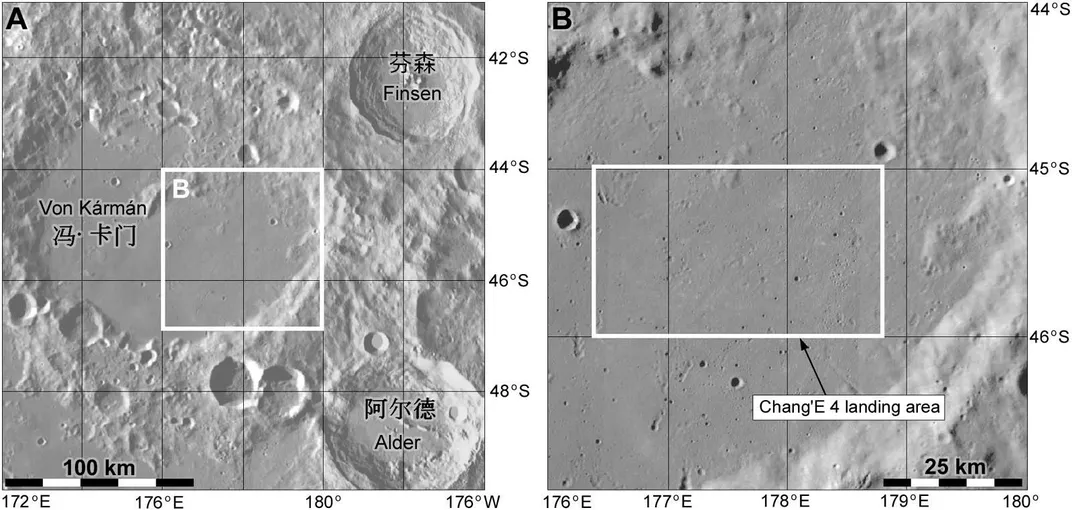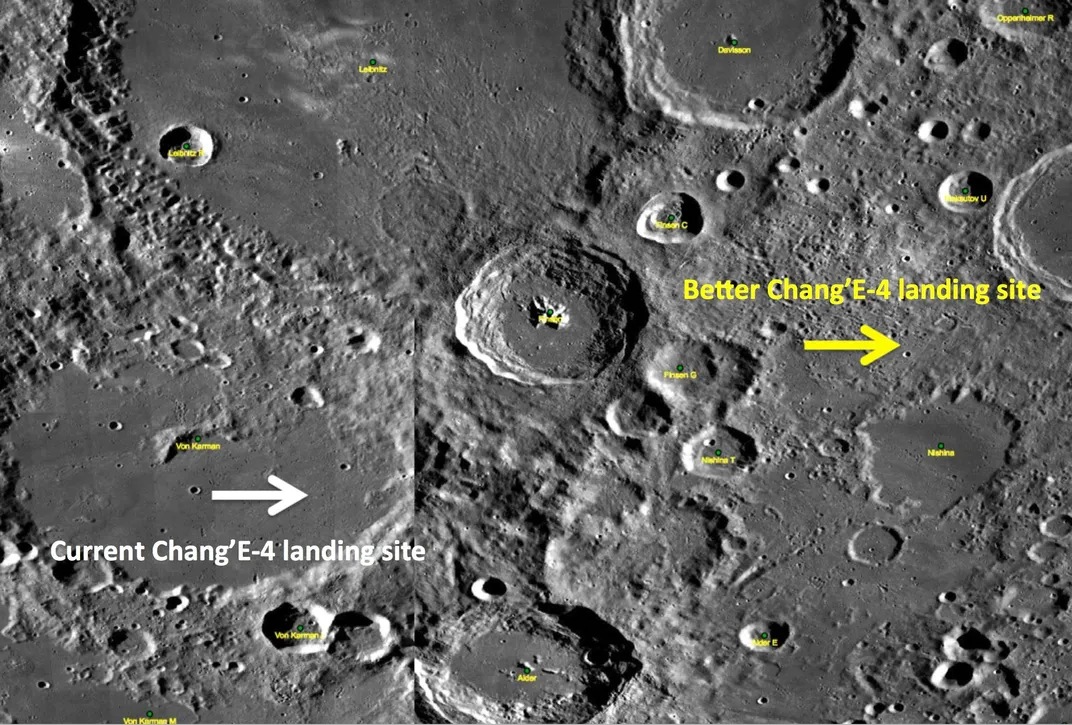China’s Journey to the Lunar Far Side: A Missed Opportunity?
New details about China’s Chang’E-4 mission suggest there might be a better place to land.
/https://tf-cmsv2-smithsonianmag-media.s3.amazonaws.com/filer/ad/8b/ad8bda90-1fc4-447c-b66e-e40b67f1c210/fig_1_change.jpeg)
From published scientific work and images of some PowerPoint slides (presented at a recent technical meeting), we now know more about China’s upcoming Chang’E-4 mission, which will culminate in China being the first nation to land and conduct experiments on the far side of the Moon. Currently scheduled for next year, the mission involves two launches. A relay satellite will be launched in May 2018, and a second launch later that year will send the Chang’E-4 spacecraft to the Moon. The relay satellite will enable communications with the Chang’E-4 lander and rover spacecraft during its descent and subsequent surface operations on the Moon’s far side. The relay satellite will slowly hover around the Earth-Moon L-2 libration point—about 60,000 kilometers above the center of the Moon’s far side—keeping both the Moon and the Earth in constant view.
I have written previously about China’s lunar program and its probable policy aims. This new mission is another, major step forward in cislunar operations—a landing on the far side of the Moon, controlled from Earth by a relay satellite at Earth-Moon L-2. China demonstrated a long-loiter capability at L-2 in 2011 when the Chang’E-2 spacecraft spent eight months there before flying off to intercept an asteroid. And during the 2013 Chang’E-3 Moon lander-rover mission, China demonstrated the ability to descend, avoid hazards, and land safely. Before the end of 2017, China’s Chang’E-5 mission will be sent to a landing site on the western near side of the Moon to collect a sample and return it to Earth. With each lunar mission, new capabilities are being added to China’s growing portfolio of deep space operations.
Of particular interest was a recent post at NASASpaceflight.com reporting that China apparently has indicated the probable landing site for the Chang’E-4 spacecraft: the crater von Karman, at 45.5°S, 178°E. The slides go on to note that this landing site is within the South Pole-Aitken (SPA) basin pictured above—the oldest and largest impact feature on the Moon.
Although the presence of this basin was recognized back in the early 1960s, its full significance was not appreciated until it was mapped for the first time during the 1994 Clementine mission. Before we had the new mapping data, the largest basin on the Moon was thought to be an obscure, irregular depression on the near side called Procellarum basin, named for the extensive, dark lava plain of Oceanus Procellarum. Procellarum basin was invoked to explain a wide variety of lunar properties, including the distribution of lava on the Moon (found mostly on the near side) and the concentration of heat-producing elements (seemingly clustered in the western near side).
Continued study of the new information demonstrated that things were not as simple as this. The Clementine mission (a mission I was involved with) showed that high concentrations of iron and titanium are present in the interior of the SPA basin, but that they are not exclusively related to the sparse deposits of mare basalt found there. Following Clementine, the Lunar Prospector mission mapped the distribution of the element thorium around the Moon, and we learned that in addition to the large concentration of thorium in the western near side, the floor of SPA basin also had elevated thorium content. Judging from the number of younger craters found on top of the SPA basin, we knew it to be the oldest impact feature on the Moon. If we could determine its absolute age (i.e., its age in years), we could better understand the early cratering history of the Moon and the Earth. In terms of topography, the SPA basin is not only the biggest basin on the Moon (2,600 km across) but also the deepest, with a rim-to-floor difference of almost 13 km (the Grand Canyon of the Colorado is 440 km across and 2 km deep). One would expect that such a very large feature, forming early in the history of the Moon, should have leveled out somewhat due to the high heat flow of early lunar history. Yet, SPA remains as deep as any basin of its size would be if it formed today on the cold, rigid Moon.
Because of these puzzling properties, lunar scientists decided that understanding the properties and formation of the SPA basin were critical to deciphering the early geological history of the Moon. Thus, when it came time to prioritize scientists’ desires for the “decadal” survey of the National Academy of Science (i.e., the prioritized list of missions requested by scientists once every ten years), the return of a sample from the floor of the SPA basin was very high on the list. Samples of this impact basin can tell us about the early history of the Moon, as well as that of Earth and other rocky planets, as all underwent similar histories with comparable processes in the earliest stages of planetary history.

The photos above, shown during the international technical meeting, indicate the chosen landing spot for Chang’E-4 is at 45.5°S, 178°E. If this information is correct, it appears that although the Chinese are going to one of the most geologically interesting sites on the Moon, they have chosen a site that will not yield much insight regarding the most pressing scientific questions about SPA basin. This landing site consists of mare lavas that fill crater von Karman, which means the rocks at this site are not related to the geology of the SPA basin floor, but rather to volcanic flooding that occurred much later. A key unanswered question for SPA is the composition of the basin floor and what it represents, as it is more mafic (i.e., more iron-rich) than the typical highlands crust—making it a significant compositional anomaly on the far side. Is the basin floor the remnant of a giant impact melt sheet? Could it be the lower crust and upper mantle of the Moon exposed by the giant collision? Or does it have some unexpected, exotic origin, resulting from processes and histories not yet imagined?
Unfortunately, answers to these questions must await another mission. The objectives of Chang’E-4 are largely operational and environmental. For operations, China will learn how to use relay satellites at L-2 to control distant craft in deep cislunar space. Learning to deal with significant time delays (~3-4 seconds) in remote controlled actions is an essential skill set for mastering future cislunar operations. Chang’E-4 will also characterize the radio environment on the far side by conducting low frequency radio observations. Such an experiment will help astronomers plan for the creation of future radio observatories on the lunar far side, a place permanently shielded from the radio noise of the Earth.
Yet, these same objectives could have been served just as well from a different location, a geologically significant site within SPA basin. If I were conducting such a mission, I would land the spacecraft in a smooth area just north of the crater Nishina, at 42.8°S, 171.6°W, pictured below.

This site is only about 240 km east of the currently planned location. The area is relatively smooth (good for landing), yet located on unambiguous basin floor material. This highlands unit contains about 10 percent by weight FeO (iron oxide) and 4-5 parts per million Th (thorium), values are typical of the SPA basin floor but distinctly higher than the rest of the highlands crust of the Moon. In order to characterize what can be found there, the lander and/or rover should carry a device capable of measuring bulk chemistry (e.g., an alpha-particle, X-ray spectrometer or a gamma-ray spectrometer) and mineralogy (imaging spectrometer). If such a payload were carried to this site, significant advancements in our understanding of the SPA basin (and thus, the history and processes of the Moon) would be made.
Regardless of where Chang’E-4 lands and which activities it undertakes on the lunar surface, it will be a milestone in the history of lunar exploration. It also signals another significant advance in China’s development of cislunar capability, something the United States should be developing in earnest. It is concerning that we are not.
/https://tf-cmsv2-smithsonianmag-media.s3.amazonaws.com/accounts/headshot/blog_headshot_spudis-300x300.jpg)
/https://tf-cmsv2-smithsonianmag-media.s3.amazonaws.com/accounts/headshot/blog_headshot_spudis-300x300.jpg)